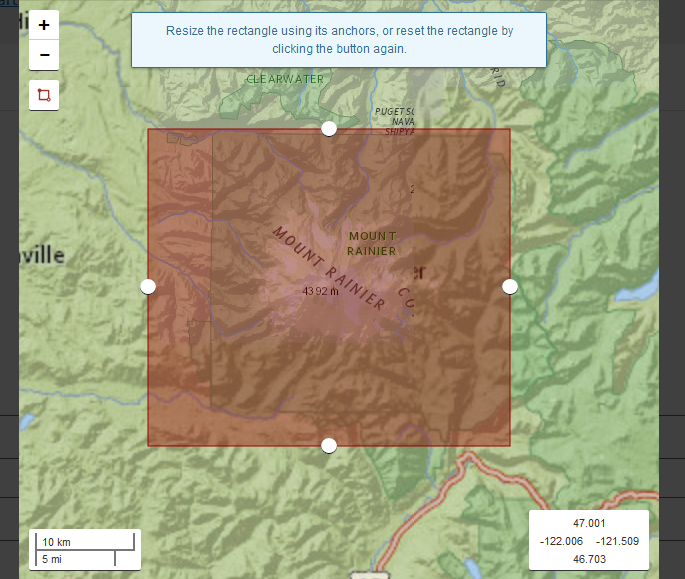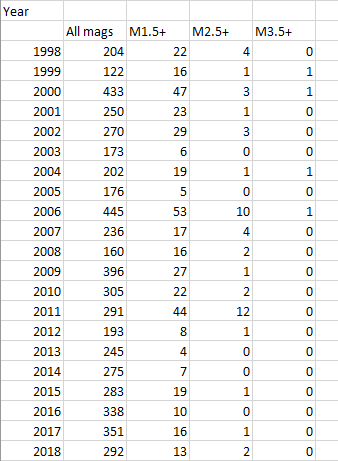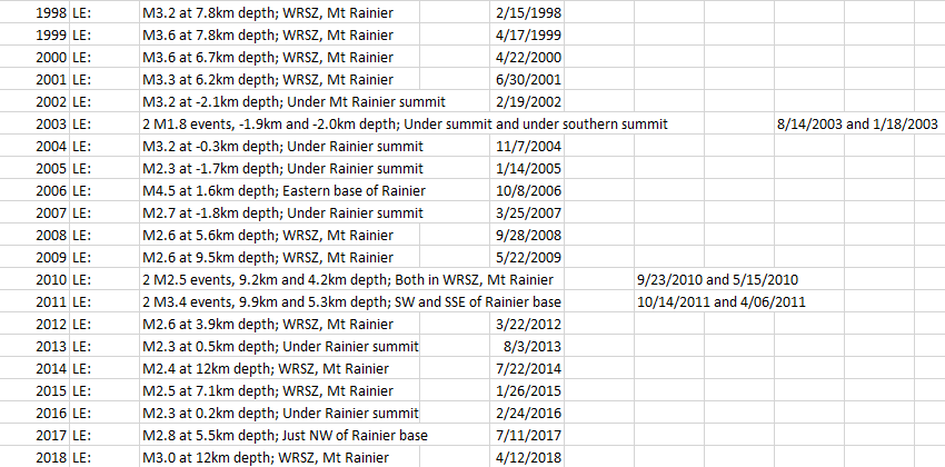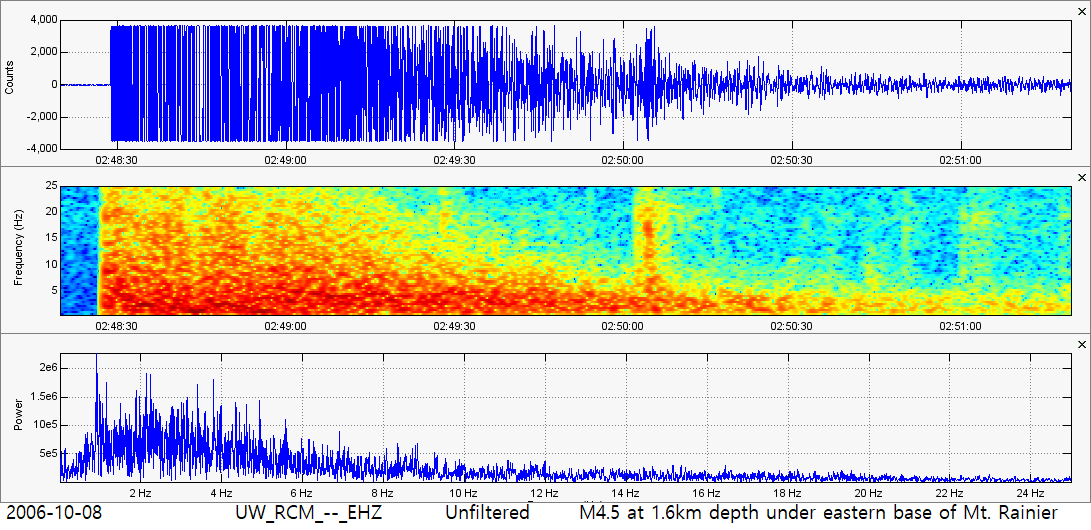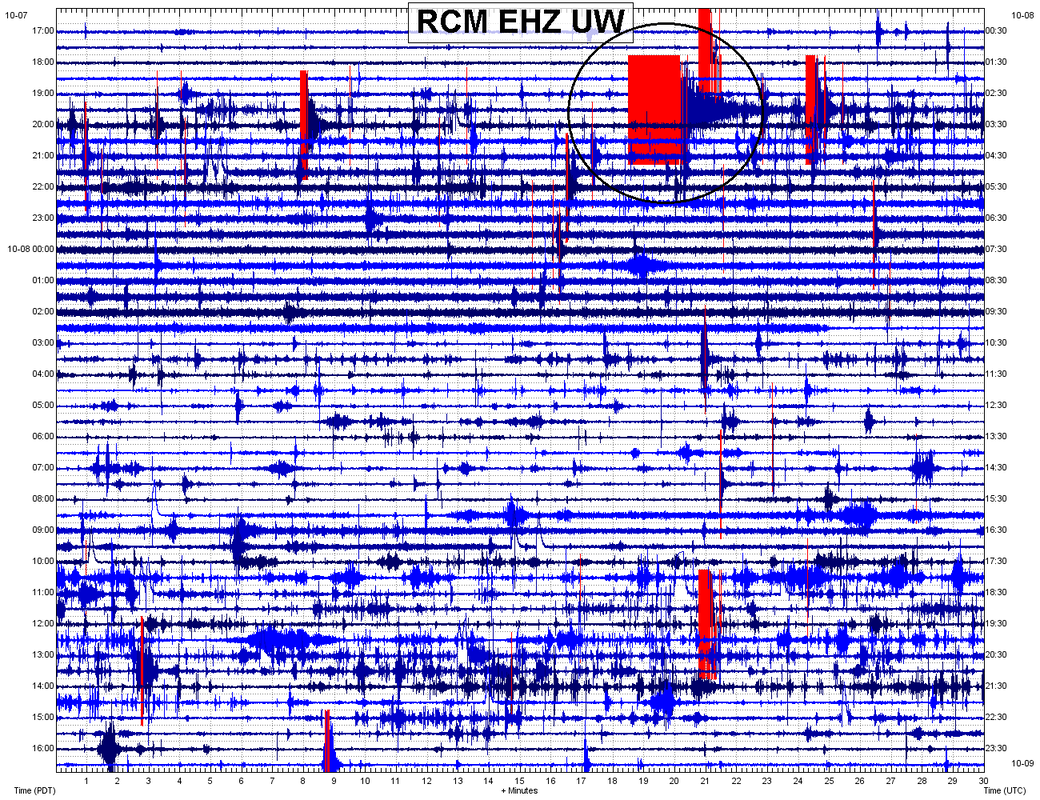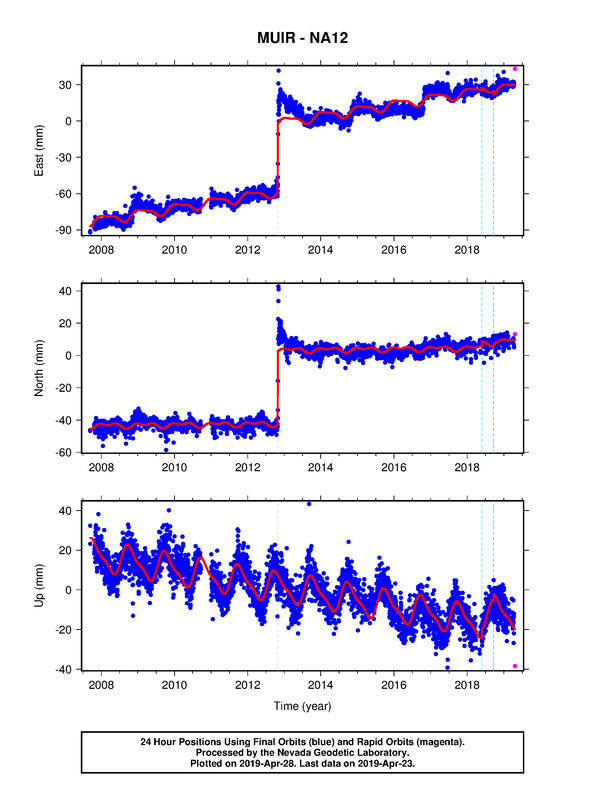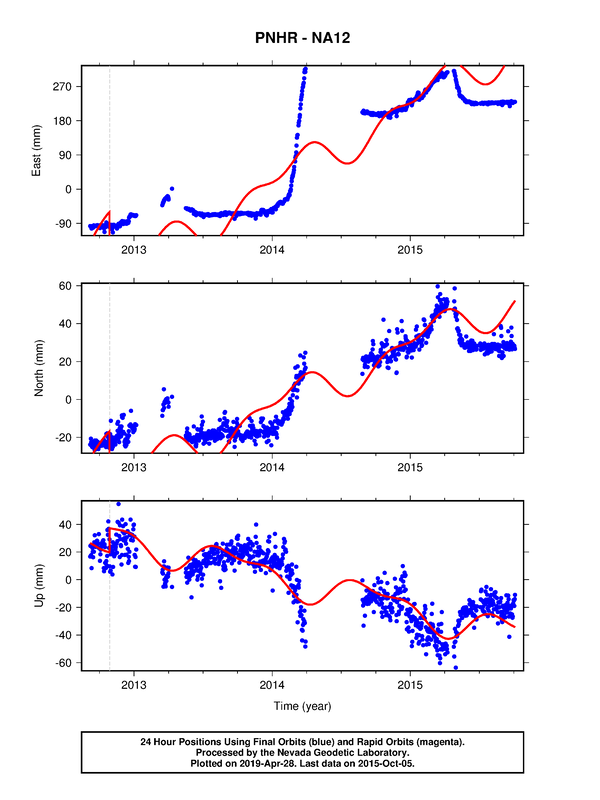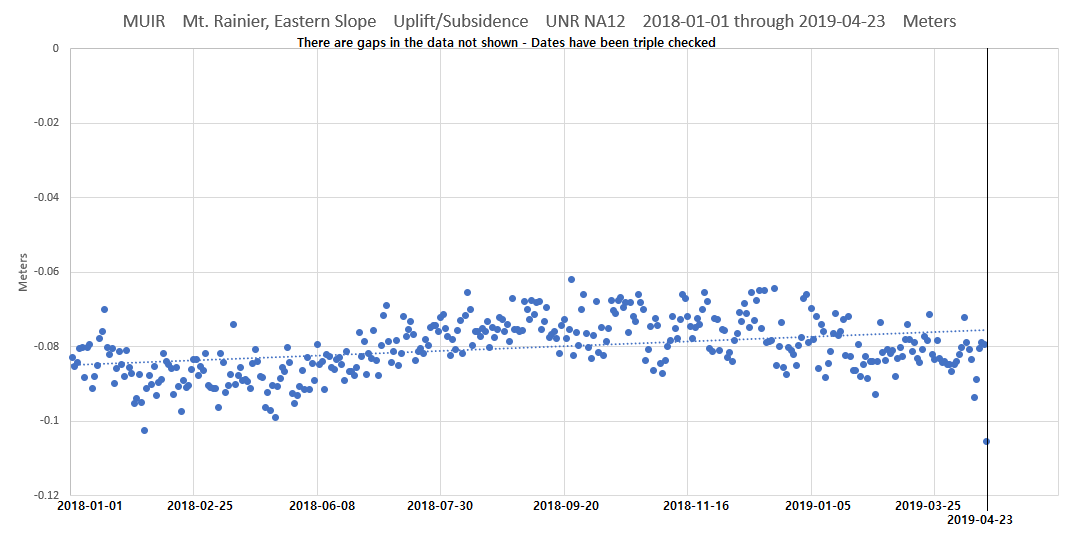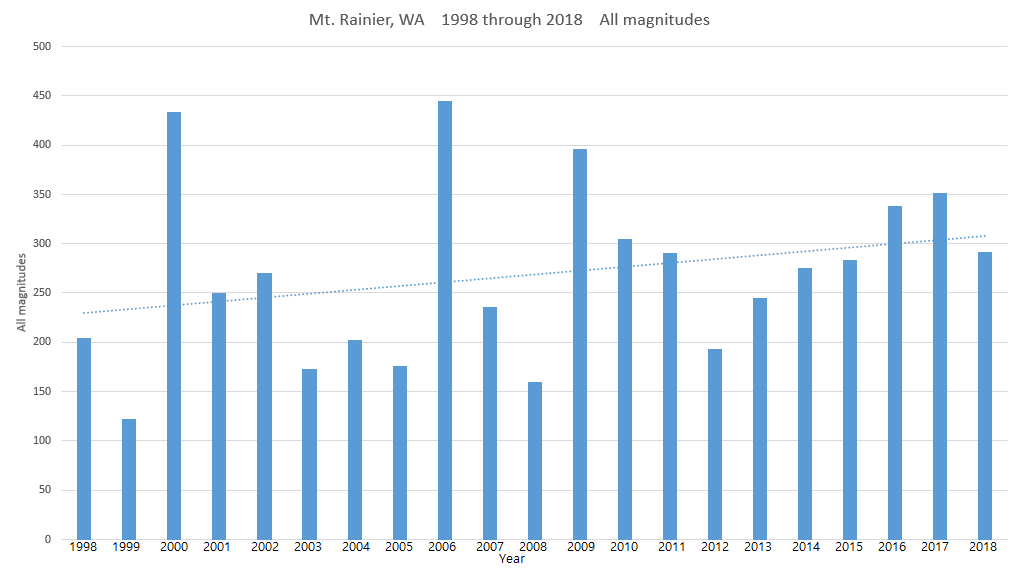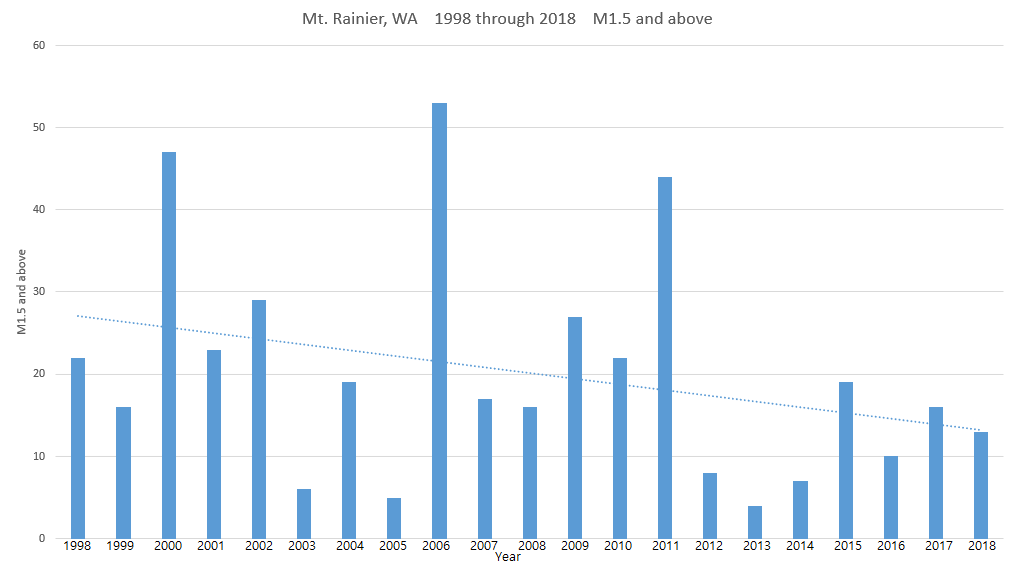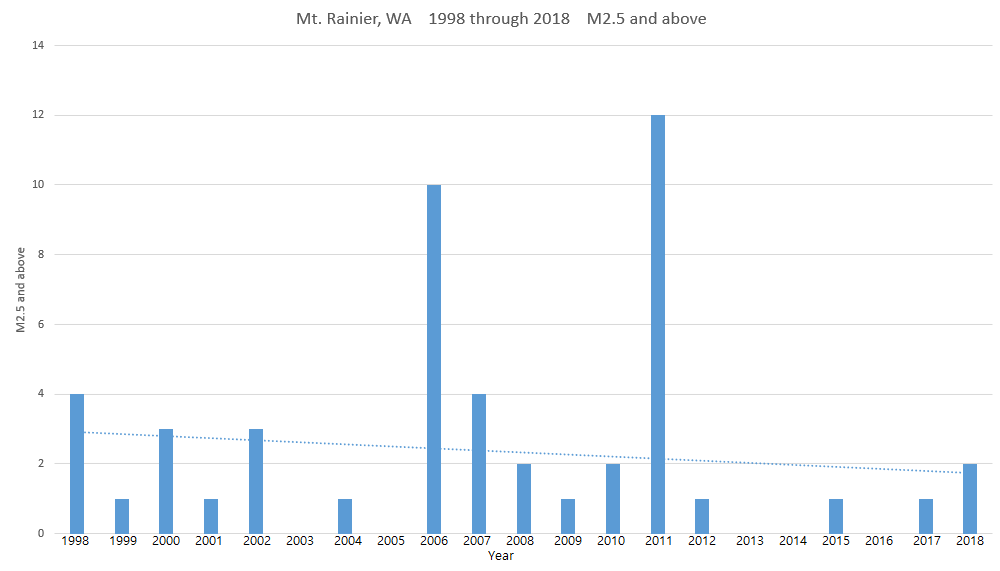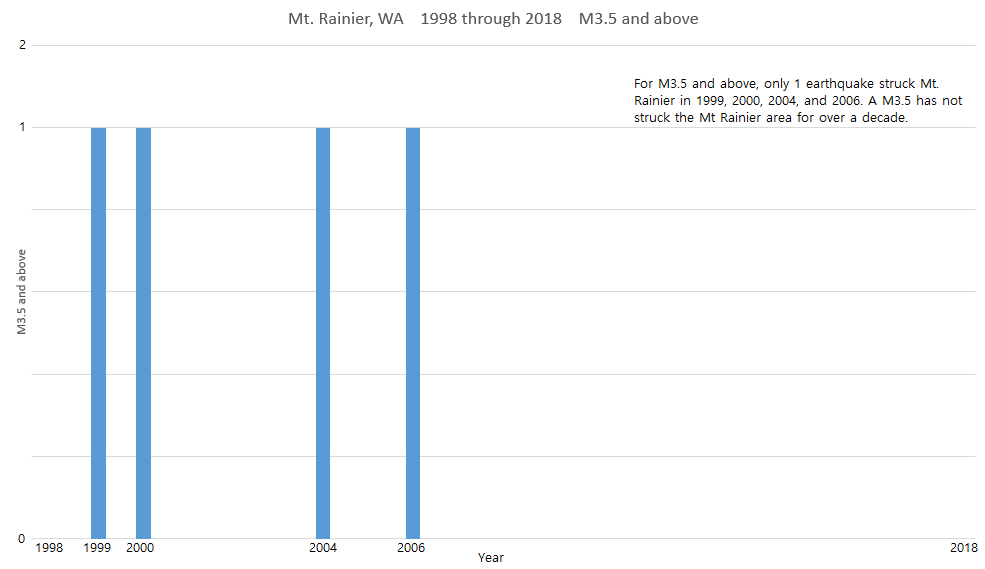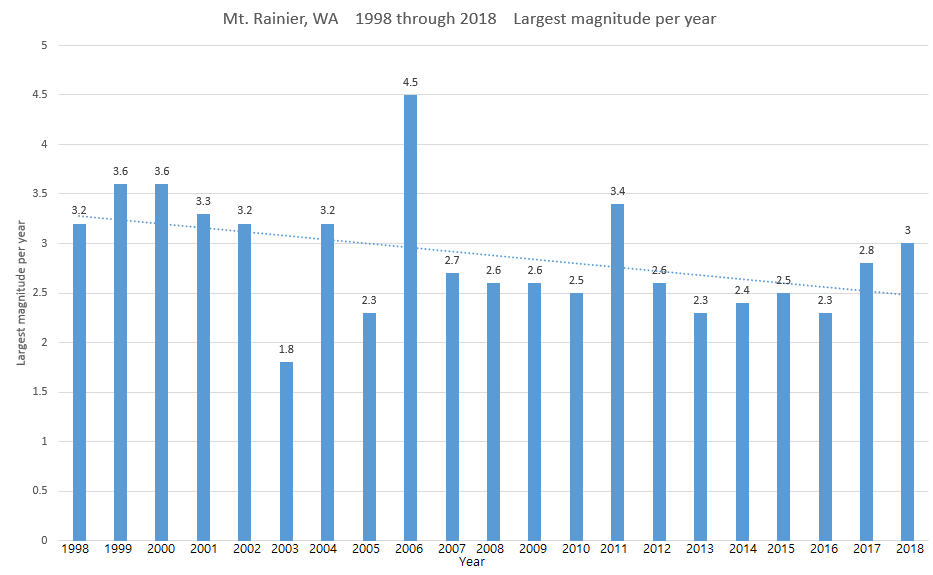The events contained within these statistics are the earthquakes REPORTED, not the ACTUAL number of earthquake events. As of the past few years, record keeping has gained momentum thanks to new technology and equipment updates. However, there are still earthquakes that are not reported by USGS even though the seismic trace of some events in question show on multiple seismic stations *shrug*. However this usually only occurs during earthquake swarms, especially at Yellowstone, and with magnitudes generally below M2.0. Every location in question will have at least 3 magnitudes showing all the earthquakes that occurred within that year at and above the magnitude in question. For example, all magnitudes, M1.5+, M2.5+, and M3.5+. But in regard to the Cascadia Subduction Zone, since it sees larger magnitudes than volcanoes, I will do all magnitudes, M2.5+, M4.0+, M5.0+, and M6.0+. I will also show the coordinate box I used and personal charts I created to give the reader a sense of how earthquake activity supposedly progressed for each magnitude throughout the years. I will also leave some GPS deformation charts if possible. As of right now, it seems earthquake counts for Long Valley caldera and the Cascadia Subduction Zone are more accurate than, for example, Newberry Caldera. Newberry didn’t have accurate seismic monitoring installed until 2011-2012. All earthquake statistics are taken directly from the earthquake catalog at earthquake.usgs.gov. Please let me know if there is anything I should change or if there are any mistakes! Of course these earthquake statistics will be updated once per year. I also encourage others to do the same that I have done!
One more thing. 0.0km in depth means sea level. So if you see an earthquake with a depth of -1.5km but the elevation of the surface is only 1.0km for example, then that means the earthquake occurred in the air. We know that is not possible so if that is true for any of the events, then that means the depth is likely to be very wrong. Another thing to add is the increase of seismic monitoring since 1998. Places like Long Valley caldera and the Cascadia Subduction Zone should not see too noticeable of an increase in reported seismicity that is related to increased monitoring, basically since these areas have been monitored closely for longer than 1998. But places like Yellowstone and Newberry caldera, the low-magnitude seismicity might increase slightly throughout time because of increased monitoring, especially in regards to Newberry. But in regards to Yellowstone, a great many small events are still not reported to this day (it being 2019 right now). This can especially be proven on my West Thumb, Yellowstone page under the Seismic Events dropdown menu above. Many, many small events are not reported even though monitoring is sufficient enough for in depth reporting. I don’t know why this is occurring, so Yellowstone might have a slightly higher seismicity count than the reported count. But most of the time quakes that occur above M1.5 or so are reported regardless.
Earthquake counts are shown first, charts visualizing progression of seismicity are shown second, and my take on the seismic progression is at the bottom. Any additional information will be provided right below. Also, my charts will contain a horizontal trendline (rising, dropping, or level). I know these are important, yes. However trendlines should not be the most important thing to look at. I have seen trendlines head downwards many times when recent activity has started to spike. They are important, but remember to always look at the data first. All dates are in UTC. UTC is ahead of Pacific Time, for example, by 7 hours. This means, for example, an earthquake occurring at 1:00UTC on April 22 would still be April 21 for us here in the USA.
Also, in regards to the largest event section, "LE" means largest event. If dealing with multiples of the same magnitudes, I will post in order from most recent. If you wish to know the locations of any of the GPS stations listed below, either CLICK HERE for the UNR map (where I got some of the deformation plots below) or CLICK HERE for the UNAVCO map. I highly suggest using the UNR map, seeing that you can see all-time plots.
DISCLAIMER: In regards to my custom GPS plot, it doesn't really allow the deformation monitoring of Rainier which I had high hopes for. There are 2 GPS stations on Rainier, with one being out of commission for many years. The only one available is MUIR on the eastern slopes of Rainier and one that is further east. Also, does it seem the dates may be incorrect on the GPS chart? They are not. Samples are supposed to be taken once per day. However, much like with Newberry Caldera, samples have many gaps sometimes lasting almost a month without taking a sample. Gaps in the data are not shown, giving the illusion that the dates are incorrect Regardless, we can still get a good idea of how uplift/subsidence was recorded on this station. Rainier is a stratovolcano. Let's say a bulge started to form on the western slopes, opposite of where MUIR is located. Maybe MUIR would detect some slight uplift, but in regards to stratovolcanoes I really wish they had one active GPS station for all sides of the volcano.
DISCLAIMER: WRSZ means "West Rainier Seismic Zone" where many earthquakes occur just west of the volcano.The large majority of the time each year, except during Mt Rainier swarms under the volcano related to volcanic, hydrothermal, or tectonic activity, half or slightly more than half of the seismicity in the Rainier area occurs under Rainier itself and the other half occurs along the West Rainier Seismic Zone (WRSZ). Also, events counted are ALL events. About 0.5% or less of the counts are explosions from mining, quarries, or lumber work. However I have never seen more than a few of them within this area per year.
One more thing. 0.0km in depth means sea level. So if you see an earthquake with a depth of -1.5km but the elevation of the surface is only 1.0km for example, then that means the earthquake occurred in the air. We know that is not possible so if that is true for any of the events, then that means the depth is likely to be very wrong. Another thing to add is the increase of seismic monitoring since 1998. Places like Long Valley caldera and the Cascadia Subduction Zone should not see too noticeable of an increase in reported seismicity that is related to increased monitoring, basically since these areas have been monitored closely for longer than 1998. But places like Yellowstone and Newberry caldera, the low-magnitude seismicity might increase slightly throughout time because of increased monitoring, especially in regards to Newberry. But in regards to Yellowstone, a great many small events are still not reported to this day (it being 2019 right now). This can especially be proven on my West Thumb, Yellowstone page under the Seismic Events dropdown menu above. Many, many small events are not reported even though monitoring is sufficient enough for in depth reporting. I don’t know why this is occurring, so Yellowstone might have a slightly higher seismicity count than the reported count. But most of the time quakes that occur above M1.5 or so are reported regardless.
Earthquake counts are shown first, charts visualizing progression of seismicity are shown second, and my take on the seismic progression is at the bottom. Any additional information will be provided right below. Also, my charts will contain a horizontal trendline (rising, dropping, or level). I know these are important, yes. However trendlines should not be the most important thing to look at. I have seen trendlines head downwards many times when recent activity has started to spike. They are important, but remember to always look at the data first. All dates are in UTC. UTC is ahead of Pacific Time, for example, by 7 hours. This means, for example, an earthquake occurring at 1:00UTC on April 22 would still be April 21 for us here in the USA.
Also, in regards to the largest event section, "LE" means largest event. If dealing with multiples of the same magnitudes, I will post in order from most recent. If you wish to know the locations of any of the GPS stations listed below, either CLICK HERE for the UNR map (where I got some of the deformation plots below) or CLICK HERE for the UNAVCO map. I highly suggest using the UNR map, seeing that you can see all-time plots.
DISCLAIMER: In regards to my custom GPS plot, it doesn't really allow the deformation monitoring of Rainier which I had high hopes for. There are 2 GPS stations on Rainier, with one being out of commission for many years. The only one available is MUIR on the eastern slopes of Rainier and one that is further east. Also, does it seem the dates may be incorrect on the GPS chart? They are not. Samples are supposed to be taken once per day. However, much like with Newberry Caldera, samples have many gaps sometimes lasting almost a month without taking a sample. Gaps in the data are not shown, giving the illusion that the dates are incorrect Regardless, we can still get a good idea of how uplift/subsidence was recorded on this station. Rainier is a stratovolcano. Let's say a bulge started to form on the western slopes, opposite of where MUIR is located. Maybe MUIR would detect some slight uplift, but in regards to stratovolcanoes I really wish they had one active GPS station for all sides of the volcano.
DISCLAIMER: WRSZ means "West Rainier Seismic Zone" where many earthquakes occur just west of the volcano.The large majority of the time each year, except during Mt Rainier swarms under the volcano related to volcanic, hydrothermal, or tectonic activity, half or slightly more than half of the seismicity in the Rainier area occurs under Rainier itself and the other half occurs along the West Rainier Seismic Zone (WRSZ). Also, events counted are ALL events. About 0.5% or less of the counts are explosions from mining, quarries, or lumber work. However I have never seen more than a few of them within this area per year.
Mt. Rainier seismicity counts:
Largest magnitudes per year:
Largest earthquake to occur from 1998 through 2018 was a M4.5 at 1.6km depth; Eastern base of Rainier on 10/8/2006. Plots shown directly below:
GPS deformation charts generated by UNR for Mt. Rainier. Remember, there is a link in the text above that gives you the map and location of where these plots originated:
My own custom GPS chart from station MUIR on the eastern slopes of Rainier:
Charts detailing data from the spreadsheets above:
My opinions/educated guesses:
Mt. Rainier is a very dangerous stratovolcano. It is considered active yet has seen a good drop in seismicity over the past decade. Studies suggest there is an absolutely massive magma reservoir connecting Mt. Adams to Mt. Rainier, with Mt. St. Helens having it's own separate system. There is literally probably enough magma in Adams and Rainier's system to fill up a super-volcano's magma chamber! Of course it is not a supervolcano, but there is a lot of volcanic potential for both Adams and Rainier.
That being said, take a look at the charts above. Every chart is basically showing a continued drop in seismicity that has been ongoing for more than a decade. Also, Rainier has not seen an earthquake above M3.5 since 2006! That is a long time. Rainier is not dead and it is confusing to me why it would be quieting down so much. Maybe the calm before the storm? But then how long will this calm last? Months? Years? Decades? We will have to wait and see. Just know, however, there was a very small increase in earthquakes the past few years but that tiny increase was short-lived. One thing to mention is the only chart above that shows an actual increase in seismicity is the "All magnitudes" chart. Maybe micro-quakes below M1.5 are dominating seismicity? Or maybe this has to do with the increase in seismic monitoring over the past 2 decades? I am going with the first option that micro-quakes below M1.5 are now dominating seismicity. Rainier has been accurately monitored for over a decade or two, maybe even longer. Regardless, Rainier is still well within background levels and seems to continue this trend.
As for the GPS deformation charts, the first two were generated by UNR and you can tell a slight overall trend of subsidence is occurring. Note the small yearly "bumps" which are caused by seasonal changes such as ice buildup, increased snowfall, etc... Also note my custom GPS chart showing recent uplift/subsidence for MUIR. It seems the seasonal trends continue. I will keep an eye on this, however.
That being said, take a look at the charts above. Every chart is basically showing a continued drop in seismicity that has been ongoing for more than a decade. Also, Rainier has not seen an earthquake above M3.5 since 2006! That is a long time. Rainier is not dead and it is confusing to me why it would be quieting down so much. Maybe the calm before the storm? But then how long will this calm last? Months? Years? Decades? We will have to wait and see. Just know, however, there was a very small increase in earthquakes the past few years but that tiny increase was short-lived. One thing to mention is the only chart above that shows an actual increase in seismicity is the "All magnitudes" chart. Maybe micro-quakes below M1.5 are dominating seismicity? Or maybe this has to do with the increase in seismic monitoring over the past 2 decades? I am going with the first option that micro-quakes below M1.5 are now dominating seismicity. Rainier has been accurately monitored for over a decade or two, maybe even longer. Regardless, Rainier is still well within background levels and seems to continue this trend.
As for the GPS deformation charts, the first two were generated by UNR and you can tell a slight overall trend of subsidence is occurring. Note the small yearly "bumps" which are caused by seasonal changes such as ice buildup, increased snowfall, etc... Also note my custom GPS chart showing recent uplift/subsidence for MUIR. It seems the seasonal trends continue. I will keep an eye on this, however.
